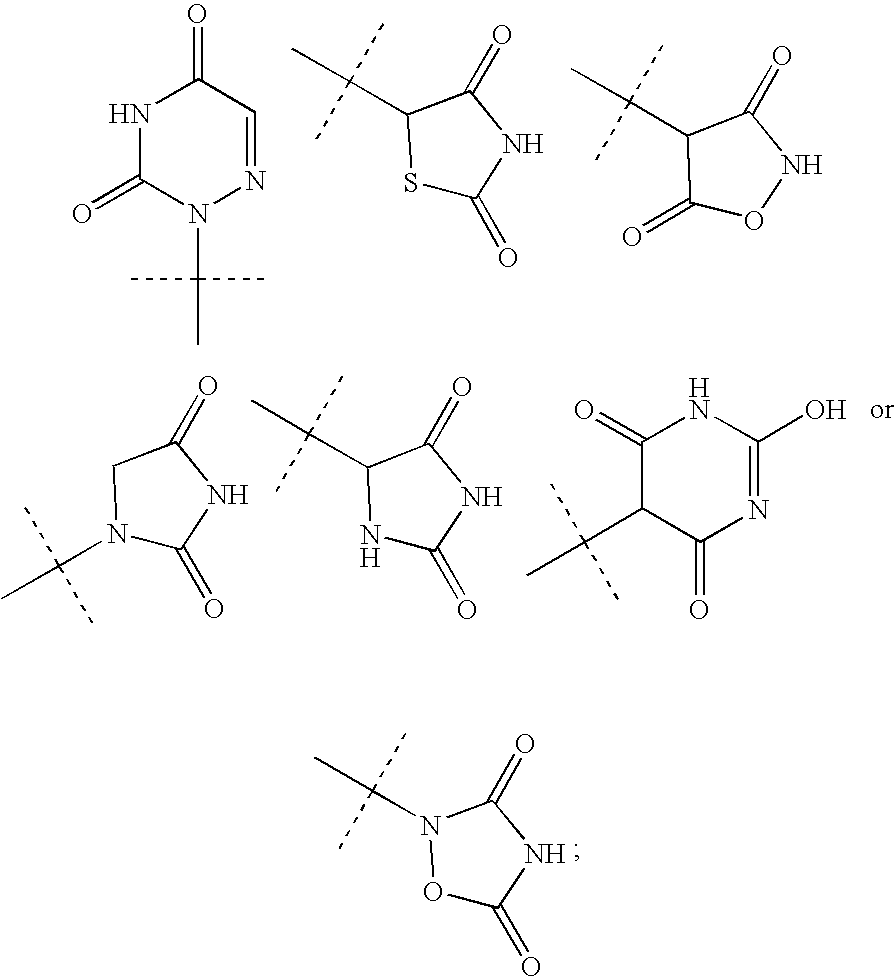Ppar modulators
- Summary
- Abstract
- Description
- Claims
- Application Information
AI Technical Summary
Benefits of technology
Problems solved by technology
Method used
Image
Examples
example 1
2-{4-[3-(2-benzoyl-4-ethyl-phenoxy)-butoxy]-2-methyl-phenoxy}-2-methyl-propionic acid
[0452]
Step A
Acetic acid 3-(toluene-4-sulfonyloxy)-butyl ester
[0453]
[0454] TEA (0.88 mL, 3.79 mmol), p-toluenesulfonyl chloride (0.72 g, 3.79 mmol) and 4-dimethylaminopyridine (0.09 g, 0.79 mmol) are added to acetic acid 3-hydroxy-butyl ester (0.41 g, 3.16 mmol) in dichloromethane (DCM) (4 mL) at 0° C. under N2, and the mixture is stirred for an hour at 0° C. The mixture is warmed gradually to ambient temperature. After 24 h, the mixture is treated with water and extracted with EtOAc. The organic layers are combined and washed with saturated aqueous sodium chloride, and then dried over magnesium sulfate and concentrated under reduced pressure. Purification by flash chromatography, silica, eluting with hexanes: EtOAc (75:25) afforded the title compound (0.71 g, 2.48 mmol, 78%) as a white solid: ES+ (m / e) 304.19 (M+NH4)+; 1H NMR (400 MHz, CDCl3) 7.79 (d, 2H, J=8 Hz), 7.33 (d, 2H, J=8 Hz), 4.65-4.80 ...
example 2
3-{4-[3-(2-benzoyl-4-ethyl-phenoxy)-butoxy]2-methyl-phenyl}propionic acid
[0463]
[0464] The compound of 3-{4-[3-(2-benzoyl-4-ethyl-phenoxy)-butoxy]-2-methyl-phenyl}-propionic acid methyl ester (21 mg, 0.05 mmol, 76%) is prepared by following the procedure described in Example 1, Step E by using triphenylphosphine (23 mg, 0.09 mmol), [5-ethyl-2-(3-hydroxy-1-methyl-propoxy-)phenyl]-phenyl-methanone (17 mg, 0.06 mmol) (Example 1, Step D), 3-(4-hydroxy-2-methyl-phenyl-propionic acid methyl ester (17 mg, 0.09 mmol) and diethylazodicarboxilate (17 μL, 0.09 mmol). ES+ (m / e) 475.29 (M+H)+, 497.29 (M+Na)+; Rf=0.42 hexanes: EtOAc (80:20).
[0465] Work up of the above propionic acid methyl ester (21 mg, 0.04 mmol) in methanol (0.5 mL) as described in Example 1, Step E provides the title compound (20 mg, 0.04 mmol, 100%): ES+ (m / e) 461.27 (M+H)+, 483.26 (M+Na)+; 1H NMR (400 MHz, CDCl3) 7.76 (d, 2H, J=7.6 Hz), 7.48-7.52 (m, 1H), 7.35-7.39 (m, 2H), 7.21-7.25 (m, 2H), 7.00 (d, J=8.4 Hz), 6.88 (d, 1H...
example 3
2-{3-[3-(2-benzoyl-4-ethyl-phenoxy)-butoxy]-phenoxy}-2-methyl-propionic acid
[0466]
[0467] The compound of 2-{3-[3-(2-benzoyl-4-ethyl-phenoxy)-butoxy]-phenoxy}-2-methyl-propionic acid ethyl ester (17 mg, 0.03 mmol, 56%) is prepared by following the procedure described in Example 1, Step E by using triphenylphosphine (24 mg, 0.09 mmol), [5-ethyl-2-(3-hydroxy-1-methyl-propoxy-)phenyl]-phenyl-methanone (18 mg, 0.06 mmol) (Step D of Example 1), 2-(3-hydroxy-phenoxy)-2-methyl-propionic acid ethyl ester (20 mg, 0.09 mmol) in toluene (0.5 mL) and diethylazodicarboxilate (18 μL, 0.09 mmol). ES+ (m / e) 505.30 (M+H)+, Rf=0.49 hexanes: EtOAc (80:20).
[0468] Work-up of the above propionic acid ethyl ester (17 mg, 0.04 mmol) in ethanol (0.5 mL) as described in Example 1, Step E provides the title compound as a colorless oil (16 mg, 0.04 mmol, 100%): ES+ (m / e) 477.29 (M+H)+, 499.26 (M+Na)+; 1H NMR (400 MHz, CDCl3) 7.78 (d, 2H, J=6.8 Hz), 7.50-7.54 (m, 1H), 7.37-7.41 (m, 2H), 7.19-7.25 (m, 2H), 7.10...
PUM
 Login to View More
Login to View More Abstract
Description
Claims
Application Information
 Login to View More
Login to View More - R&D
- Intellectual Property
- Life Sciences
- Materials
- Tech Scout
- Unparalleled Data Quality
- Higher Quality Content
- 60% Fewer Hallucinations
Browse by: Latest US Patents, China's latest patents, Technical Efficacy Thesaurus, Application Domain, Technology Topic, Popular Technical Reports.
© 2025 PatSnap. All rights reserved.Legal|Privacy policy|Modern Slavery Act Transparency Statement|Sitemap|About US| Contact US: help@patsnap.com



